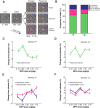The Effects of Methylphenidate (Ritalin) on the Neurophysiology of the Monkey Caudal Prefrontal Cortex
- PMID: 30847388
- PMCID: PMC6402537
- DOI: 10.1523/ENEURO.0371-18.2018
The Effects of Methylphenidate (Ritalin) on the Neurophysiology of the Monkey Caudal Prefrontal Cortex
Abstract
Methylphenidate (MPH), commonly known as Ritalin, is the most widely prescribed drug worldwide to treat patients with attention deficit disorders. Although MPH is thought to modulate catecholamine neurotransmission in the brain, it remains unclear how these neurochemical effects influence neuronal activity and lead to attentional enhancements. Studies in rodents overwhelmingly point to the lateral prefrontal cortex (LPFC) as a main site of action of MPH. To understand the mechanism of action of MPH in a primate brain, we recorded the responses of neuronal populations using chronic multielectrode arrays implanted in the caudal LPFC of two macaque monkeys while the animals performed an attention task (N = 2811 neuronal recordings). Over different recording sessions (N = 55), we orally administered either various doses of MPH or a placebo to the animals. Behavioral analyses revealed positive effects of MPH on task performance at specific doses. However, analyses of individual neurons activity, noise correlations, and neuronal ensemble activity using machine learning algorithms revealed no effects of MPH. Our results suggest that the positive behavioral effects of MPH observed in primates (including humans) may not be mediated by changes in the activity of caudal LPFC neurons. MPH may enhance cognitive performance by modulating neuronal activity in other regions of the attentional network in the primate brain.
Keywords: Ritalin; attention; methylphenidate; multielectrode array; prefrontal cortex; primates.
Figures







References
Publication types
MeSH terms
Substances
Grants and funding
LinkOut - more resources
Full Text Sources
